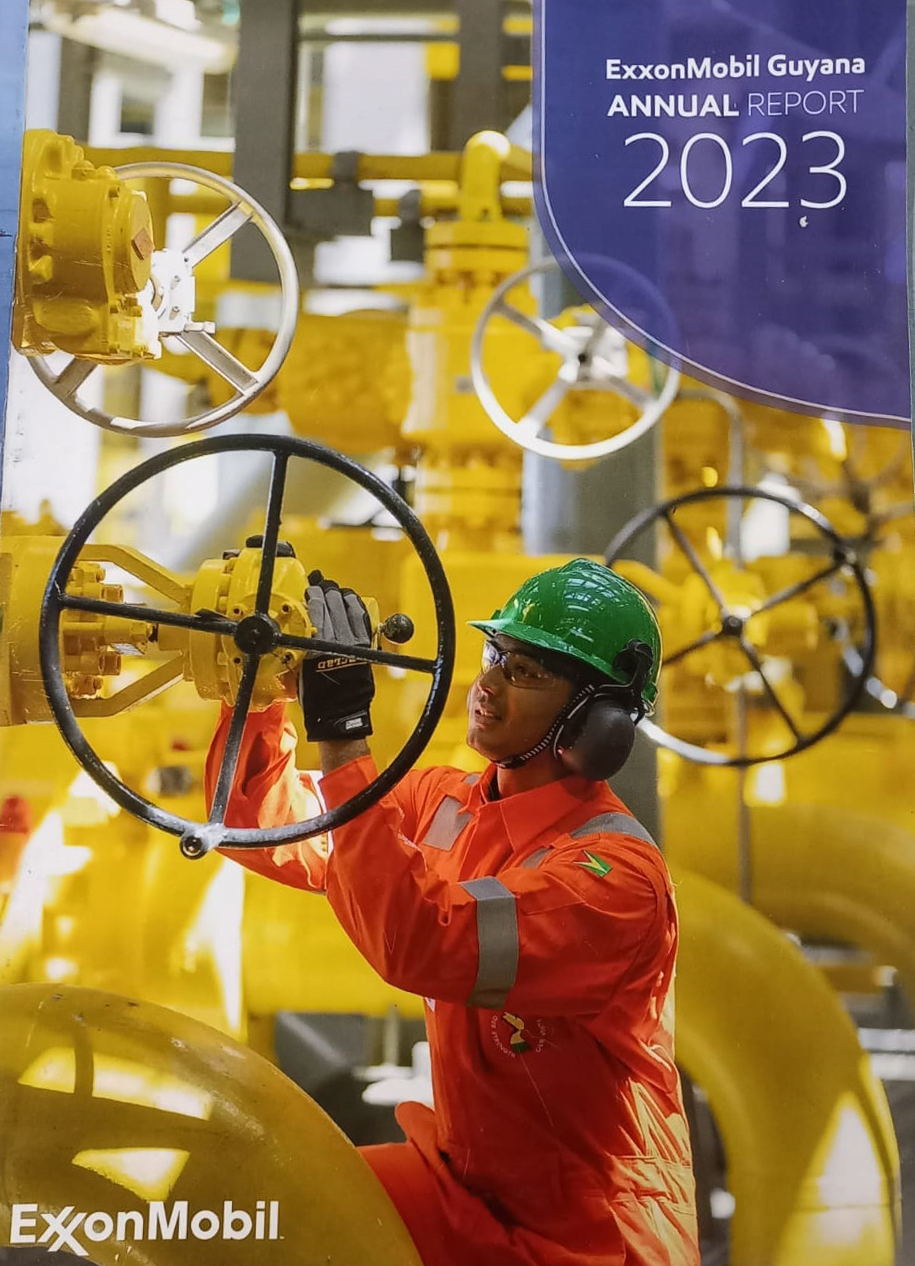-revenues equivalent to Guyana’s entire 2024 budget
ExxonMobil Guyana Limited (EMGL) declared a net profit of $614.6b for 2023, up by $36.9b compared to 2022 and its revenue from last year was almost equivalent to Guyana’s entire budget for 2024.
The first Annual Report under its new name, EMGL which was changed from Esso Exploration and Production Guyana Limited last year, the ExxonMobil subsidiary stated that it encountered five dry holes, compared to one in 2022, but that that will not deter their commitment to the Production Sharing Agreement (PSA) it has with this country to maximize exploration in the Stabroek Block.
“In 2023, as you can see in the financial statement, was another profitable year. We increased our profits year over year to around GUY$600b. It is reflective of building on the successes of prior years,” Vice President and Business Services Manager, Phillip Rietema on Thursday told a press briefing following the distribution of the Annual Report.
And as the company celebrates 25 years since it signed the PSA with Guyana in 1999, its records show that revenue for last year was pegged at $1.108 trillion. Guyana’s entire budget this year was $1.146 trillion, underlining the massive take ExxonMobil and its two other partners are getting as a result of the controversial 2016 PSA.
Also of note in the report was the huge increase in exploration costs over the period, highlighting the company’s aggressive programme and further deferring increased profits to Guyana.
Exploration costs in 2022 were pegged at $8.74b and this figure zoomed to $55.49b last year. Royalty paid to Guyana rose from $18.89b in 2022 to $21.92b last year. Production costs went up slightly from $39.74b in 2022 to $41.12b last year. Lease interest expense climbed significantly from $21.94b in 2022 to $38.35b last year.
Controversially, its income tax expense jumped from $59.38b in 2022 to $138.18b in 2023. Based on the 2016 PSA, Guyana is paying this income tax on behalf of ExxonMobil and therefore the state is not benefiting from this tax. ExxonMobil is however able to state that it has paid such taxes as the report does indicate.
The report is replete with statements about ExxonMobil’s financial impact on the economy, an attribute that jars with years-long criticism of the 2016 PSA as a giveaway with a paltry 2% royalty, no ring fencing of costs and serious questions over claims for expenses.
EMGL said that it continued to make substantial investments in Guyana with total assets increasing 44% to $3.2t.
The company also stated that “through year end 2023, EMGL and its coventurers have invested more than $6t in the Stabroek Block and have committed to invest an additional $5t through 2027”.
EMGL stated that it made a US$9b investment and on the production side the Prosperity FPSO was added with a current capacity of 232,000 barrels of oil per day to supplement the Liza Destiny (160,000bpd) and Unity (252 bpd) working in the Stabroek Block.
“With continued reliable operations and start-up of the Prosperity FPSO in November 2023, gross production increased 41% and revenues by 26% versus 2022, despite lower oil prices.” Where United States dollars are quoted, the company said that the exchange rate of $210 to one was US$1 was used.
The report said that with growing production, Guyana got 17m “profit oil barrels, and when combined with a 41% increase in cash royalty payments, delivered $338b to the NRF (Natural Resource Fund) – a new annual record”.
“We are financially strong and we’re getting stronger year after year as we continue to invest in profitable projects,” Rietema said at the briefing.
The company boasted that it continues to bring benefits to this country stating that more than $758b has been paid into Guyana’s Natural Resource Fund from the Stabroek Block since first production in December 2019, supporting rapid expansion of the government’s budget and growing investment.
“Guyana receives 50% of profit oil revenues plus additional 2% in royalties. What does that mean for Guyana? The more oil we produce the bigger Guyana profits,” the report states.
Rietema underscored that the Report was done in accordance with the International Financial Reporting Standards (IFRS) and that the company accounts for every penny spent. However, of note was that IFRS requirements differ from how financial activities are accounted for under the 1999 PSA where under that regime it is prepared on an accrual basis while the current PSA mainly follows an ‘as spent’ basis.
In a letter in the report, ExxonMobil Guyana President Alistair Routledge spoke of greater efficiency and lower greenhouse gases.
“We are proud to be developing Guyana’s oil and gas with greater efficiency and lower greenhouse gas emissions due to the application of new technologies”, he said. He then referenced what he termed an “and” equation.
“This speaks to ExxonMobil’s pursuit of the “and” equation – where we can produce the products that societies need and lead in reducing greenhouse gas emissions, both our own and others’”, he said.
He also adverted to Exxon’s drive towards 1.3 million barrels of oil per day by the end of 2027 by which time he said that six oil producing platforms will be operating in the Stabroek Block.
The report identifies the massive rise in investment in new Floating Production, Storage and Offloading (FPSOs) platforms. The first, Liza Destiny was pegged at US$4.4b; the second, Liza Unity at US$6b; the third, Prosperity at US$9b; the fourth, One Guyana at US$10b; the fifth, Errea Wittu at US$12.7b and sixth, Jaguar at US$12.7b.
The report said that EMGL’s Geosciences Operations team presided over the largest Ocean Bottom Node (OBN) seismic acquisition in ExxonMobil’s history.
“This survey was also the first OBN seismic survey in Guyana. This massive effort covered an area more than 2,400 (square kilometres) and required simultaneous operations across multiple FPSOs, project vessels and active drill centres”, the report said. The seismic data, it added, will aid the subsurface teams’ understanding of fluid movement in the producing reservoirs and, “in turn allows for the teams to optimize future well locations to maximize hydrocarbon recovery”.
50,000 skilled workers
The report noted that a study commissioned by the Greater Guyana Initiative – a $20b investment by EMGL and its partners – found that approximately 50,000 additional skilled workers will be required across five sectors between 2023 and 2028. The results of the study were disseminated to participating stakeholders in December of 2023.
The report stated that there were “no serious safety or environmental incidents during 2023”. It said it achieved 21,332,203 hours worked.






